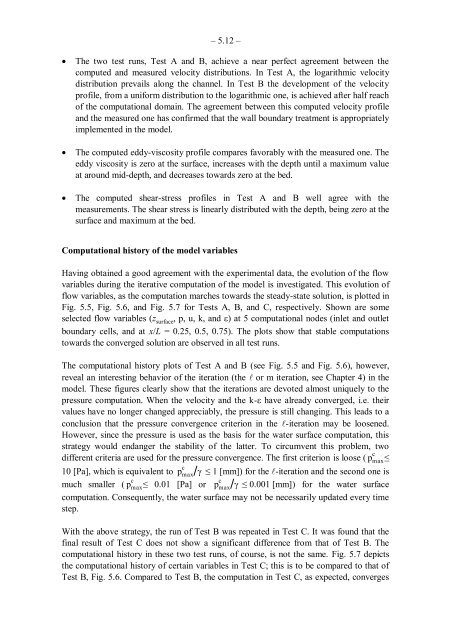Create successful ePaper yourself
Turn your PDF publications into a flip-book with our unique Google optimized e-Paper software.
– 5.12 –<br />
� The two test runs, Test A and B, achieve a near perfect agreement between the<br />
computed and measured velocity distributions. In Test A, the logarithmic velocity<br />
distribution prevails along the channel. In Test B the development of the velocity<br />
profile, from a uniform distribution to the logarithmic one, is achieved after half reach<br />
of the computational domain. The agreement between this computed velocity profile<br />
and the measured one has confirmed that the wall boundary treatment is appropriately<br />
implemented in the model.<br />
� The computed eddy-viscosity profile compares favorably with the measured one. The<br />
eddy viscosity is zero at the surface, increases with the depth until a maximum value<br />
at around mid-depth, and decreases towards zero at the bed.<br />
� The computed shear-stress profiles in Test A and B well agree with the<br />
measurements. The shear stress is linearly distributed with the depth, being zero at the<br />
surface and maximum at the bed.<br />
Computational history of the model variables<br />
Having obtained a good agreement with the experimental data, the evolution of the flow<br />
variables during the iterative computation of the model is investigated. This evolution of<br />
flow variables, as the computation marches towards the steady-state solution, is plotted in<br />
Fig. 5.5, Fig. 5.6, and Fig. 5.7 for Tests A, B, and C, respectively. Shown are some<br />
selected flow variables (z surface , p, u, k, and �) at 5 computational nodes (inlet and outlet<br />
boundary cells, and at x/L = 0.25, 0.5, 0.75). The plots show that stable computations<br />
towards the converged solution are observed in all test runs.<br />
The computational history plots of Test A and B (see Fig. 5.5 and Fig. 5.6), however,<br />
reveal an interesting behavior of the iteration (the � or m iteration, see Chapter 4) in the<br />
model. These figures clearly show that the iterations are devoted almost uniquely to the<br />
pressure computation. When the velocity and the k-� have already converged, i.e. their<br />
values have no longer changed appreciably, the pressure is still changing. This leads to a<br />
conclusion that the pressure convergence criterion in the �-iteration may be loosened.<br />
However, since the pressure is used as the basis for the water surface computation, this<br />
strategy would endanger the stability of the latter. To circumvent this problem, two<br />
c<br />
≤<br />
different criteria are used for the pressure convergence. The first criterion is loose ( pmax c<br />
10 [Pa], which is equivalent to pmax c c<br />
much smaller ( pmax≤ 0.01 [Pa] or pmax<br />
� ≤ 1 [mm]) for the �-iteration and the second one is<br />
� ≤ 0.001 [mm]) for the water surface<br />
computation. Consequently, the water surface may not be necessarily updated every time<br />
step.<br />
With the above strategy, the run of Test B was repeated in Test C. It was found that the<br />
final result of Test C does not show a significant difference from that of Test B. The<br />
computational history in these two test runs, of course, is not the same. Fig. 5.7 depicts<br />
the computational history of certain variables in Test C; this is to be compared to that of<br />
Test B, Fig. 5.6. Compared to Test B, the computation in Test C, as expected, converges

















